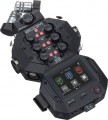Microphone type
The built-in microphone type determines the mode (number of channels) in which the voice recorder records sound.
—
Mono. The simplest option: one microphone that records sound in mono format, i.e. without separation into left and right channels. It is impossible to provide a "surround" sound with such a recording, however, in the case of voice recorders, this is not decisive, because. usually in such a recording it is not the volume of the sound that is important, but the intelligibility of speech — and it is fully provided by a monophonic microphone.
—
Stereo. In this case, a pair of microphones is usually used, spaced apart on the sides of the case; the sound is recorded in stereo, and the volume of the sound is achieved due to the difference in the sound reaching the left and right microphones. Considered somewhat more advanced than mono, although it does not provide better speech intelligibility by itself.
Microphone
— Built-in. In this case, it is understood that the recorder can only use its own built-in microphone when recording; Connectors for connecting an external microphone are not provided. This reduces the size of the device, simplifies the design and eliminates the confusion with wires. At the same time, built-in microphones usually provide slightly worse recording quality than external ones.
— Built-in / external. Such a voice recorder can record both from its own built-in microphone, and from
an external one connected to the appropriate connector. This expands the possibilities of using the device: when compactness and maximum convenience are important, you can use the built-in microphone, and if the high quality of the recorded sound is critical, an external one is connected, which usually provides noticeably better volume and intelligibility. An external microphone is usually not included; on the other hand, it gives you the opportunity to choose a model for specific needs.
— External. Dictaphones without a built-in microphone with the ability to connect an external one. This allows you to choose the right type of device for specific needs and change them as needed. Refers to professional activity.
Maximum recording time
The maximum continuous recording time for the voice recorder. It depends primarily on the amount of memory (see "Built-in memory", "Memory card slot"), it is also directly related to the recording quality: the higher the quality, the more space the material occupies and the shorter the maximum recording time. In this regard, manufacturers usually indicate in the specifications the maximum possible recording time, that is, the recording time with minimum quality; with higher quality and time will be less.
Additional features
—
Connecting to a computer. The ability to connect the recorder to a computer, usually via a USB interface. Such a connection can be used to save recorded data on a computer, update the recorder's firmware, and some models allow using them as USB drives and even card readers (if there is a slot for memory cards, see above).
—
Smartphone control. The ability to control the device remotely from a mobile device. First of all, the function is necessary for recorders that can be installed out of reach of your hands and any movement, pressing a button on the case can adversely affect the recording. But at the moment some new hit can be written.
—
Lock buttons. The lock prevents the voice recorder from reacting to accidental button presses — for example, when carrying in a tight pocket or purse with a lot of things. By turning it on, you don't have to worry that accidental contact will start recording and drain the battery, erase files, etc. This feature is usually turned on and off by a slider, by pressing multiple buttons at the same time, or in some other way that eliminates the possibility of accidentally unlocking.
— MP3 player. The ability to use the recorder as an MP3 player to listen to music. Technically, almost all models with MP3 support have this capability (see “Recording Format”), however, some voice recorders have a separate “Player” pro
...gramme mode that makes listening more convenient. Typically, the player function requires a headphone output (see below).
— FM tuner. The tuner allows you to use the player as an FM receiver — in this range today the vast majority of music radio stations broadcast. Some models with a tuner have the function of recording from the air.
— Built-in speaker. On the voice recorder with its own speaker, you can listen to recorded materials without using additional equipment (headphones) or connecting to a computer. It can also be used to play music and FM radio (if available); however, the sound quality of such a speaker is usually not high, and its main purpose is to listen to the actual recordings.
— Headphone output. A connector that allows you to connect headphones to the recorder. Their purpose is generally similar to the built-in speaker (see above), however, the sound quality of even inexpensive headphones is often significantly higher. As a result, it is quite possible to comfortably listen to not only recordings, but also music, radio programs, etc. through headphones. (if available). In addition, headphones are well suited for noisy environments. even open models still provide some sound insulation.smartphone control
Possibility of remote control of the sound recorder from a mobile phone. First of all, the function is necessary for those recorders that can be placed out of reach of the hands. Also, remote control will come in handy when any movement or pressing a button can adversely affect the recording.
